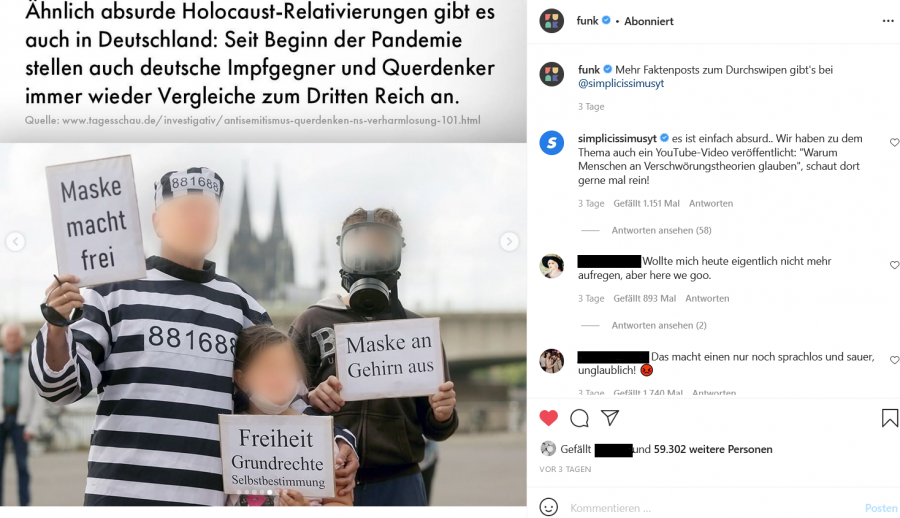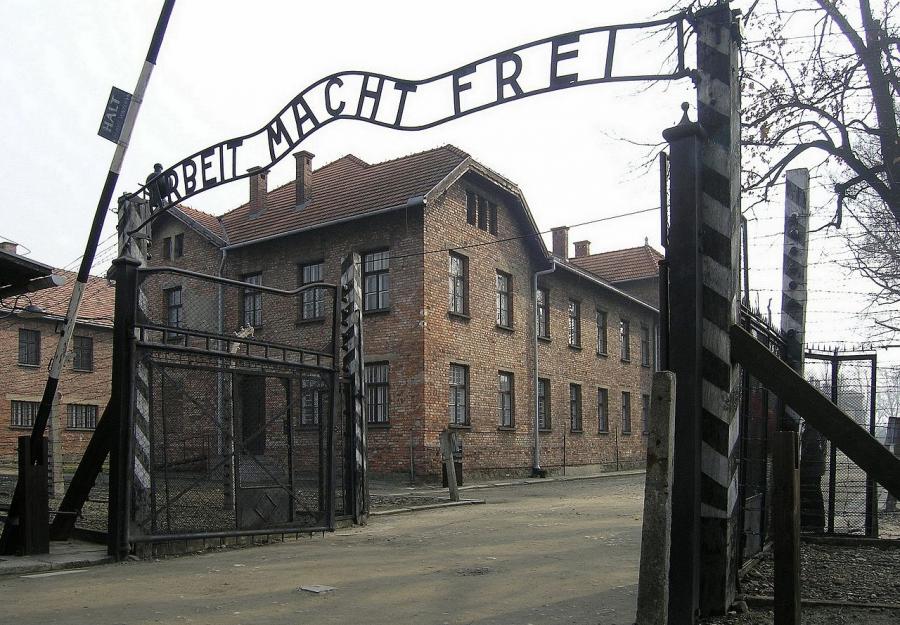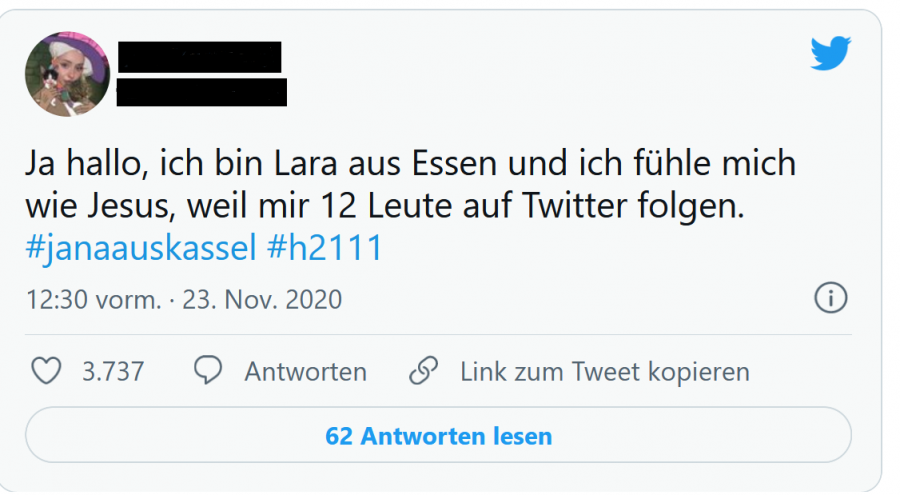
How anti-vaxxers trivialize the Holocaust
In 1933, the Nationalsozialistische Deutsche Arbeiterpartei (National Socialist German Workers' Party) led by Adolf Hitler came to power and transformed Germany into a dictatorship; the Third Reich. The totalitarian state controlled nearly every part of the citizen's life. Consequently, democratic values such as freedom of speech, opinion, assembly, and press were abolished as well as the concepts of diversity and equality. Besides Nazism, Antisemitism was one of the central ideologies of the oppressive state. During the Second World War, Jews were structurally segregated from other citizens within Nazi-occupied countries. Moreover, Jews were forced to wear the Star of David to make their 'identity' recognizable. Furthermore, Nazi propaganda disputed the humanity of Jews. In the Holocaust, six million Jews alongside various enemies of national socialism such as communists, socialists, etc. were deported to concentration camps and killed by the totalitarian regime (Wikipedia, 2021).
Aa s result of the worldwide Covid-19 pandemic that started to spread in 2019, anti-vaxxers started to instrumentalize Germany's Third Reich history to publicly express critique towards the government's Covid management including, mandatory masks, lockdowns, and vaccination.
This article provides a Discourse Analysis of anti-vaxxers in the context of the Covid-19 pandemic. To elaborate further, it will be investigated how anti-vaxxers trivialize the Holocaust by making use of Germany's Nazi history to protest against the pandemic management. Data will be analyzed by focusing on the following concepts: recontextualization (Blommaert, 2020), intertextuality (Blommaert, 2020), indexicality (2020), and semiotics (Blommaert, 2014).
Clothing and signs at assemblies

Figure 1 An antivaxxer at a protest over Covid-19 measures. Where injustice becomes justice, resistence becomes mandatory. Unvaccinated
Figure 1 shows an anti-vaxxer at a demonstration of Covid-19 measures. The man is wearing a shirt with a Star of David with the label "unvaccinated". Thus, the anti-vaxxer refers to the time of the Holocaust and recontextualizes the symbol of the Star of David. He gives it a new meaning by introducing it in another context: the Covid-19 pandemic. The historical meaning of the Star of David in the Third Reich is the oppression and segregation of Jews led by the totalitarian state. However, the anti-vaxxer inscribed it with a new meaning. In the context of Covid-19, he willingly labels himself as "unvaccinated" through the star at an assembly in a democratic state that allows him to express his opinion freely. Through the new meaning of the symbol, he labels himself as a member of the anti-vaxxer movement and compares himself to victims of the Holocaust. The message of the recontextualized symbol is that as an unvaccinated citizen in Germany during the Covid-19 pandemic he faces similar oppression as Jews during the time of the Third Reich.
Moreover, the star is a sign of division. Thus, he compares the segregation of Jews and non-Jewish citizens in Nazi times with the different treatment of vaccinated and non-vaccinated citizens in Germany during the pandemic that occurred in the 2G rule for instance. The indexicality of the star is used to create meaning: the history of the semiotic in the context of an assembly against Covid politics expresses criticism towards the laws. The anti-vaxxers claim that Germany's politics lacks the concept of equality and freedom like the Third Reich due to their Covid-19 management.
The following picture (Figure 2) shows a comparison of the Star of David during the Second World War and the anti-vaxxers star that is instrumentalized to criticize the new rules by the government during the pandemic. We can observe, that the stars are identical except for the label that changed from 'jew' to 'unvaccinated'.

Figure 2 The comparison of the third Reich star of david and the unvaccinated 'star of david'
The unvaccinated star trivializes the Holocaust since the horrific segregation and murder of Jews cannot be compared to unvaccinated people who cannot enter a cafe without a Covid test. Furthermore, the question of getting vaccinated is their choice while Jews in the Third Reich were born into their fate. Additionally, living in a free democracy cannot be compared to Hitler's dictatorship.
The protester's sign in Figure 1 shows the text "where injustice becomes justice, resistance becomes mandatory" which is a quote by the German poet Bertolt Brecht who survived World War II by living in exile (Wikipedia, 2021). The sign in combination with his clothing is a reference to Nazi Germany. The Queerdenker describes the anti-vaxxer movement as 'resistance against injustice' and thus recontextualizes the meaning of historical resistance by introducing it to the context of the pandemic. Therefore, he instrumentalizes the indexical meaning of resistance and makes meaning through the text-context relation. Describing protests as resistance like in Nazi times downplays the courage that freedom fighters of the resistance proved during the Third Reich.

Figure 3 anti-vaxxers at a protest in Cologne. There is absurd Holocaust relativization in Germany: Since the beginning of the pandemic, also German anti-vaxxers and 'Querdenker' make comparisons to the Third Reich.
Mask sets you free, freedom fundamental rights and self-determination, mask on brain off
Another example of anti-vaxxers making Nazi references during the Covid-19 pandemic can be seen in Figure 3. The content network funk uploaded an informational post about this topic on Instagram. Funk is a verified account on Instagram as shown by the blue badge next to the name. This indicates that the Instagram account is of public interest. Moreover, funk belongs to Öffentlich Rechtlicher Rundfunk means that the account publishes reliable content that has gone through the procedure of fact and source checking. This is crucial in times of Covid-19 where misinformation circulates rapidly on social media. The image above shows three people: a man, a young girl, and a boy. The man is wearing a prisoner uniform with a number and holds up the sign "mask sets you free", the boy is wearing a gas mask and shows the sign "mask on brain off" and the girl's sign says "freedom, fundamental rights, and self-determination".
Figure 4 The concentation camp prisoners uniform (this example from KZ Mauthausen)
Figure 3 again portrays how anti-vaxxers make use of symbolic clothing and signs at protests. The uniform of the man is a reference to the Holocaust victims as it looks like the uniform of concentration camp prisoners (see Figure 4). Additionally, he gave himself a number (881688). This links to Jewish prisoners in KZ's that were assigned a number as an act of dehumanization. Thus, the anti-vaxxer redefines the meaning of the prisoner uniform and number by recontextualizing the symbol from the Holocaust to Covid-19 politics.

Figure 5 The entrance gate of the concentartion camp Ausschwitz (Poland). Work sets you free
Likewise, the man's sign that reads "mask sets you free" connects to the Holocaust as the opening gate of the concentration camp Auschwitz in Poland says "work sets you free" as Figure 5 shows.
Hence, the anti-vaxxer changes the intertextual meaning of the Nazi's quote "work sets you free" that glorified forced labor of prisoners under horrifying inhuman conditions in the camps while fearing one's life. In contrast to the historical meaning, the altered text "mask sets you free" in the context of the pandemic indicates that the man links the law that made masks mandatory to the totalitarian state system of the Third Reich. He suggests that mandatory mask regulation is comparable to the dictatorship under Hitler that was inscribed in propaganda. This opinion links to the conspiracy theory that mistrusts the government and scientific facts that masks protect people. Even though the World Health Organization has proven the effectiveness of masks.
The fact that the boy wears a gas mask as a protest against Covid-19 measures also transforms the meaning that the tool had during World War II. Again, meaning is created by different contexts. His sign "mask on brain off" linked to his outfit shows the connection between Hitler's propaganda state and the German government during the pandemic that anti-vaxxers draw.
The girl's sign expresses the protester's demands; "freedom, fundamental rights, and self-determination". Consequently, the three protesters transform the meaning of their strategically chosen clothing and signs to express criticism towards the German government. The new intertextual meaning is that due to the pandemic, Germany is not a democracy anymore but a terror state that limits basic human rights as well as democratic rights such as freedom of thought.
The message of the anti-vaxxers is also shaped by indexicality. The picture shows that the protesters create meaning, through the strategical use of words and semiotics that are embossed by NS history and express a message through their use within the Covid-19 context. Again, Antivaxxers compare themselves as equal victims of Covid politics as Jews under the Nazi regime which derides the seriousness of the Holocaust.
Another way that creates meaning to content is the sender of the Instagram post. Funk not only informs about the topic but also frames the actions of anti-vaxxers; they describe it as an "absurd Holocaust relativization". Thus, the journalistic uptake in form of critical evaluation is also an instance of recontextualizing the signs. Through reposting the picture, funk changes the original audience which changes the semiotic scope and results in a way of meaning-making. This can also be seen in the negative responses of the audience. Red angry face emojis show negative responses from users. Furthermore, comments like "this makes me speechless and angry, unbelievable!" and "I did not want to get mad anymore but here we goo" underline the rage of users. Additionally, the post's likes show that 59.303 users agree with funk that the anti-vaxxers are relativizing the Holocaust through their protesting methods.
Speech at demonstration
Figure 6 A speech of an anti-vaxxer at an assembly
Furthermore, anti-vaxxers' trivialization of the Holocaust is stressed in the speech of the Queerdenker "Jana from Kassel" (Figure 6). During the speech, she compares herself to the Nazism resistance fighter Sophie Scholl who was a crucial member of the organization 'the white rose' and was murdered by Nazis during the Second World War. The anti-vaxxer argues that she feels like Sophie Scholl because she has been" active in the resistance for months" by "making speeches, walking on demos, handing out flyers, and registering for gatherings". Moreover, she elaborates that she is 22 years old just like Sophie Scholl when she fell victim to the Nazis. By introducing the concept of Nazism resistance to the context of a Covid protest the Queerdenker redefines the meaning of the term resistance. Historically, resistance meant to show courage against a terror state rooted in national socialism. In the context of Covid-19, it means to freely express disagreement with the laws of the government. By portraying her actions as similar to Sophie Scholl's activism within the white rose resistance, she trivializes the braveness of the life-risking fight against the Nazi regime. Jana and Sophie Scholl are not in the same position. The significant difference can be detected within her own speech; she is able to publicly hold speeches, walk on demos, hand out flyers, and register for gatherings without facing consequences because she lives in a democracy, not in an obsessive state.
Responses to the speech
Opinions on the speech are divided. Figure 6 shows that protesters at the anti-Covid measures demonstration give Jana applause stressing their approval of the content of her speech. However, one security man who initially helped to organize the Covid-protest interrupts the Queerdenker's speech by quitting his job mid-speech. He emphasizes that he does not want to go along with her trivialization of the Holocaust. The man describes her comparison as "bullshit" and "more than embarrassing" and distances himself from the NS reference. Hence, it has to be highlighted that within the anti-vaxxer movement, members have differing opinions toward Holocaust comparisons.

Figure 7 Hello, I am Lara from Essen and feel like Jesus because 12 people follow me on Twitter #janaauskassel #h2111
Outside of the anti-vaxxer movement, the opinions about the video were dominated by indignation. As the video went viral the speech holder Jana faced a shitstorm. The hashtag #janaauskassel (#janafromkassel) emerged on Twitter where people started mocking the speech highlighting the absurdity of the comparison of the democratic Covid-laws in Germany and the totalitarian Third Reich (Figure 7).

Figure 8 A response on twitter to the speech
Sophie Scholl, Anne Frank...These are unbearable comparisons. The difference: One can freely express themselves at assemblies, while the others sacrifice their life for the resistance against the terror state and fear deportation and murder #janafromkassel
The German politician Katja Mast joined the debate on Twitter and participated in #janaauskassel as shown in Figure 8.
While other users on Twitter make fun of anti-vaxxers comparing Germany's democratic Covid measure to the Nazi regime through #janaauskassel (Figure 7), Katja Mast instrumentalizes the hashtag to inform and express her perspective on the speech. Her Twitter account fits this intention since she is a verified user and public figure in the field of politics. Hence, she occurs as authentic and reliable. She describes the comparison as "unbearable" and explains the difference between Covid protesters and resistance fighters in Nazi-occupied Europe. The difference between Germany's democratic state system and the NS dictatorship becomes crucial in her argument of why the comparison is unbearable: "One can freely express themselves at assemblies, while the others sacrifice their life for the resistance against the terror state and fear deportation and murder". This difference shows that the comparison and reference of the Nazi regime in the context of the Covid-19 pandemic is trivializing the Holocaust. It downplays the strength that It took to fight for justice within an inhumane terror state. Moreover, it demonstrates a misinterpretation and repression of German history in the case of a hyper-sensitive topic. The politician Heiko Maas elaborates "Nothing connects Covid protests with resistance fighters. Nothing!" on Twitter.
Finally, anti-vaxxers' Nazi comparisons are contradictory. They protest that Germany lost its democratic values and compare the Covid-management to the Third Reich while they make use of freedom of opinion, speech, and assembly as shown in Figures 1, 3, and 6.
Downplaying Germany's Nazi history
The Discourse analysis has revealed how anti-vaxxers trivialize the Holocaust by examining protesters' clothing, signs, and speeches at demonstrations.
It becomes obvious that they compare the Covid-19 restrictions with the totalitarian dictatorship of the Third Reich and portray themselves as equal victims of Germany's government as Jews in Nazi-occupied Europe.
Anti-vaxxers redefine the intertextual meaning of Nazi symbols such as the star of David, concentration camp uniforms, prisoner numbers, the opening gate of Auschwitz, gas masks, and the concept of Nazism resistance by applying it to the context of the Covid-19 pandemic. Thus, they change the meaning of these semiotics. Moreover, they instrumentalize the indexicality of words and semiotics to express their message. Another instance of making meaning is that funk and the guardian repost these actions. Therefore, they recontextualize the signs by changing the audience and putting the phenomenon of Holocaust comparisons with the Covid measures in a bad light. This has led to negative comments and a shitstorm on Twitter (#janafromkassel).
Lastly, the comparison can be understood as disrespectful towards the victims of the Holocaust since it downgrades the seriousness of sensitive events within Germany's history. Therefore, it can be concluded that a group of anti-vaxxers trivialize the Holocaust.
References:
Blommaert, J. (2014, June 10). Semiotic and spatial scope: Towards a materialist semiotics. Academia.Edu
Blommaert, J. (2020, June 16). Jan Blommaert on intertextuality. YouTube
Blommaert, J. (2020, June 16). Jan Blommaert on indexicality. YouTube
Blommaert, J. (2020, June 25). Jan Blommaert on entextualization. YouTube
Carter, A. (2021, December 2). 2G in shops and contact restrictions: Germany adopts tougher COVID rules. IamExpat
Maas, H. (2020, November 22). "Nothing connects Covid protests with resistance fighters. Nothing!". Twitter
Ruhdorfer, I. (2020, November 26). Jana aus Kassel hat uns den Moment beschert, den wir uns seit Monaten wünschen. Krautreporter.
The National WWII Museum, M. (2020, February 21). Sophie Scholl and the White Rose. The National WWII Museum | New Orleans.
Wikipedia contributors. (2021, December 1). Bertolt Brecht. Wikipedia.
Wikipedia contributors. (2021, December 8). The Holocaust. Wikipedia.
World Health Organization. (2020, December 1). Coronavirus disease (COVID-19): Masks. World Health Organization.